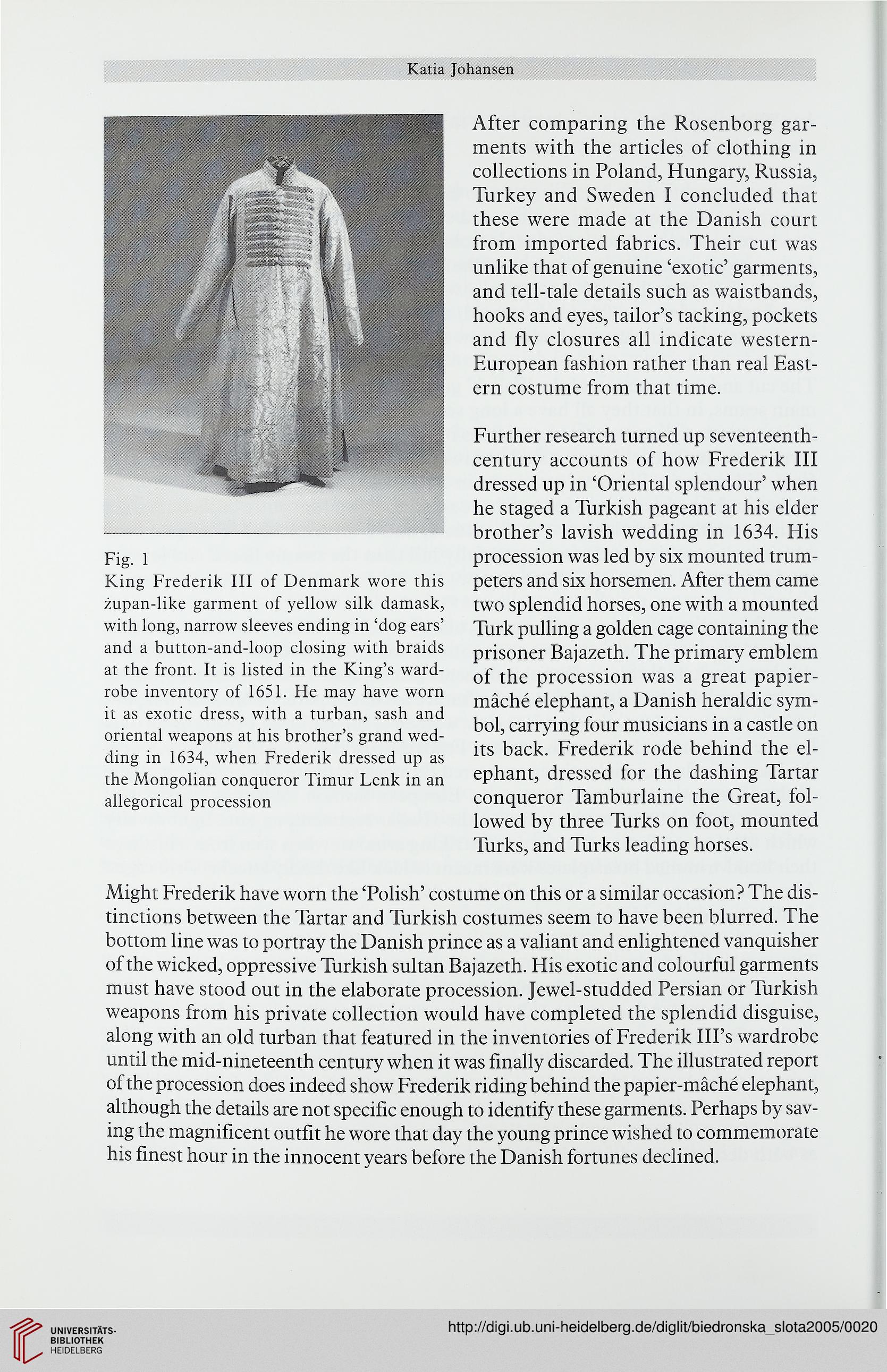Katia Johansen
Fig. 1
King Frederik III of Denmark wore this
żupan-like garment of yellow silk damask,
with long, narrow sleeves ending in 'dog ears'
and a button-and-loop closing with braids
at the front. It is listed in the King's ward-
robe inventory of 1651. He may have worn
it as exotic dress, with a turban, sash and
oriental weapons at his brother's grand wed-
ding in 1634, when Frederik dressed up as
the Mongolian conąueror Timur Lenk in an
allegorical procession
After comparing the Rosenborg gar-
ments with the articles of clothing in
collections in Poland, Hungary, Russia,
Turkey and Sweden I concluded that
these were made at the Danish court
from imported fabrics. Their cut was
unlike that of genuine 'exotic' garments,
and tell-tale details such as waistbands,
hooks and eyes, tailor's tacking, pockets
and fly closures all indicate western-
European fashion rather than real East-
ern costume from that time.
Further research turned up seventeenth-
century accounts of how Frederik III
dressed up in 'Oriental splendour' when
he staged a Turkish pageant at his elder
brother's lavish wedding in 1634. His
procession was led by six mounted trum-
peters and six horsemen. After them came
two splendid horses, one with a mounted
Turk pulling a golden cage containing the
prisoner Bajazeth. The primary emblem
of the procession was a great papier-
mache elephant, a Danish heraldic sym-
bol, carrying four musicians in a castle on
its back. Frederik rode behind the el-
ephant, dressed for the dashing Tartar
conąueror Tamburlaine the Great, fol-
lowed by three Turks on foot, mounted
Turks, and Turks leading horses.
Might Frederik have worn the 'Polish' costume on this or a similar occasion? The dis-
tinctions between the Tartar and Turkish costumes seem to have been blurred. The
bottom line was to portray the Danish prince as a valiant and enlightened vanquisher
of the wicked, oppressive Turkish sułtan Bajazeth. His exotic and colourful garments
must have stood out in the elaborate procession. Jewel-studded Persian or Turkish
weapons from his private collection would have completed the splendid disguise,
along with an old turban that featured in the inventories of Frederik III's wardrobe
until the mid-nineteenth century when it was finally discarded. The illustrated report
of the procession does indeed show Frederik riding behind the papier-mache elephant,
although the details are not specific enough to identify these garments. Perhaps by sav-
ing the magnificent outfit he wore that day the young prince wished to commemorate
his finest hour in the innocent years before the Danish fortunes declined.
Fig. 1
King Frederik III of Denmark wore this
żupan-like garment of yellow silk damask,
with long, narrow sleeves ending in 'dog ears'
and a button-and-loop closing with braids
at the front. It is listed in the King's ward-
robe inventory of 1651. He may have worn
it as exotic dress, with a turban, sash and
oriental weapons at his brother's grand wed-
ding in 1634, when Frederik dressed up as
the Mongolian conąueror Timur Lenk in an
allegorical procession
After comparing the Rosenborg gar-
ments with the articles of clothing in
collections in Poland, Hungary, Russia,
Turkey and Sweden I concluded that
these were made at the Danish court
from imported fabrics. Their cut was
unlike that of genuine 'exotic' garments,
and tell-tale details such as waistbands,
hooks and eyes, tailor's tacking, pockets
and fly closures all indicate western-
European fashion rather than real East-
ern costume from that time.
Further research turned up seventeenth-
century accounts of how Frederik III
dressed up in 'Oriental splendour' when
he staged a Turkish pageant at his elder
brother's lavish wedding in 1634. His
procession was led by six mounted trum-
peters and six horsemen. After them came
two splendid horses, one with a mounted
Turk pulling a golden cage containing the
prisoner Bajazeth. The primary emblem
of the procession was a great papier-
mache elephant, a Danish heraldic sym-
bol, carrying four musicians in a castle on
its back. Frederik rode behind the el-
ephant, dressed for the dashing Tartar
conąueror Tamburlaine the Great, fol-
lowed by three Turks on foot, mounted
Turks, and Turks leading horses.
Might Frederik have worn the 'Polish' costume on this or a similar occasion? The dis-
tinctions between the Tartar and Turkish costumes seem to have been blurred. The
bottom line was to portray the Danish prince as a valiant and enlightened vanquisher
of the wicked, oppressive Turkish sułtan Bajazeth. His exotic and colourful garments
must have stood out in the elaborate procession. Jewel-studded Persian or Turkish
weapons from his private collection would have completed the splendid disguise,
along with an old turban that featured in the inventories of Frederik III's wardrobe
until the mid-nineteenth century when it was finally discarded. The illustrated report
of the procession does indeed show Frederik riding behind the papier-mache elephant,
although the details are not specific enough to identify these garments. Perhaps by sav-
ing the magnificent outfit he wore that day the young prince wished to commemorate
his finest hour in the innocent years before the Danish fortunes declined.




